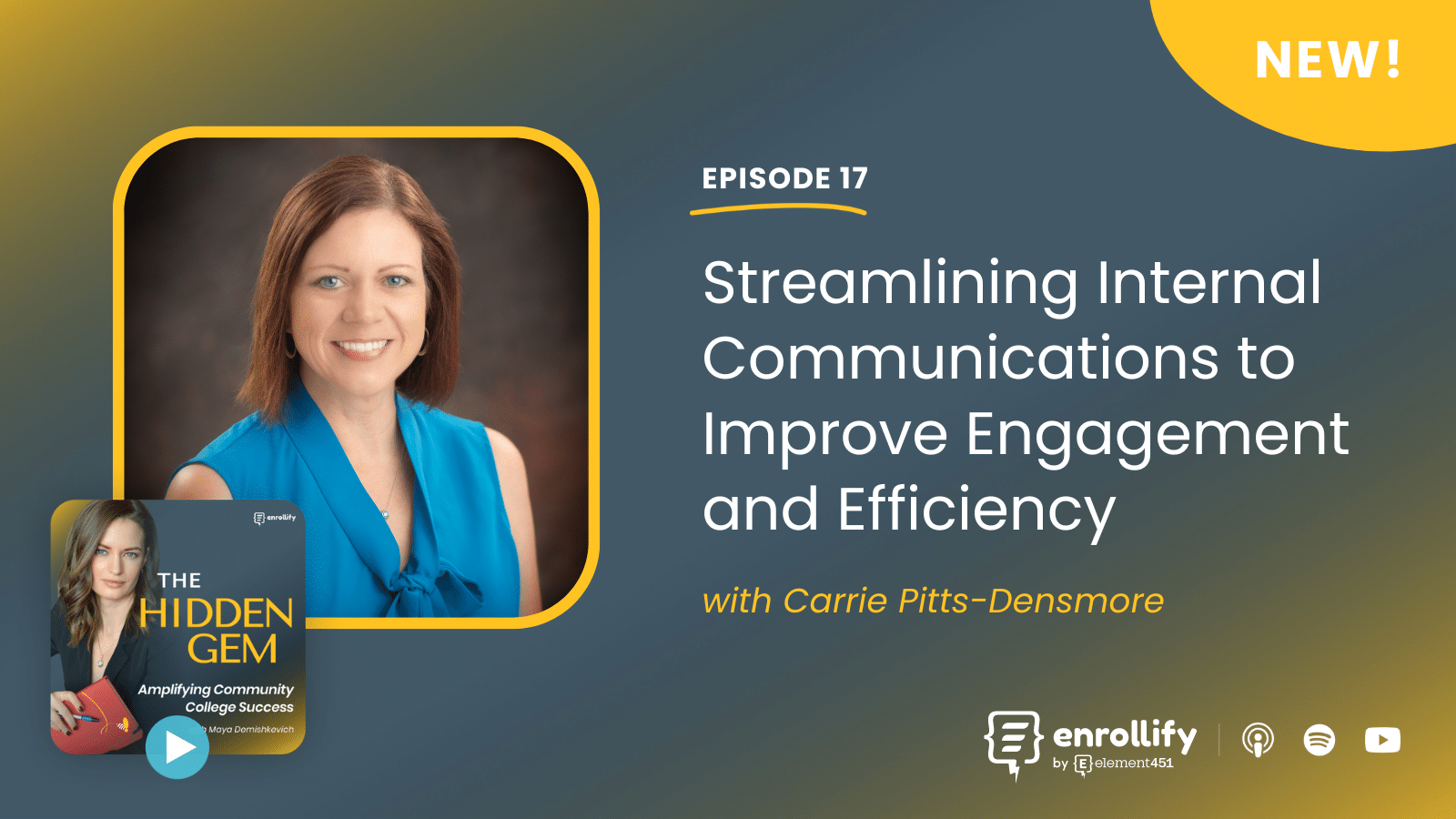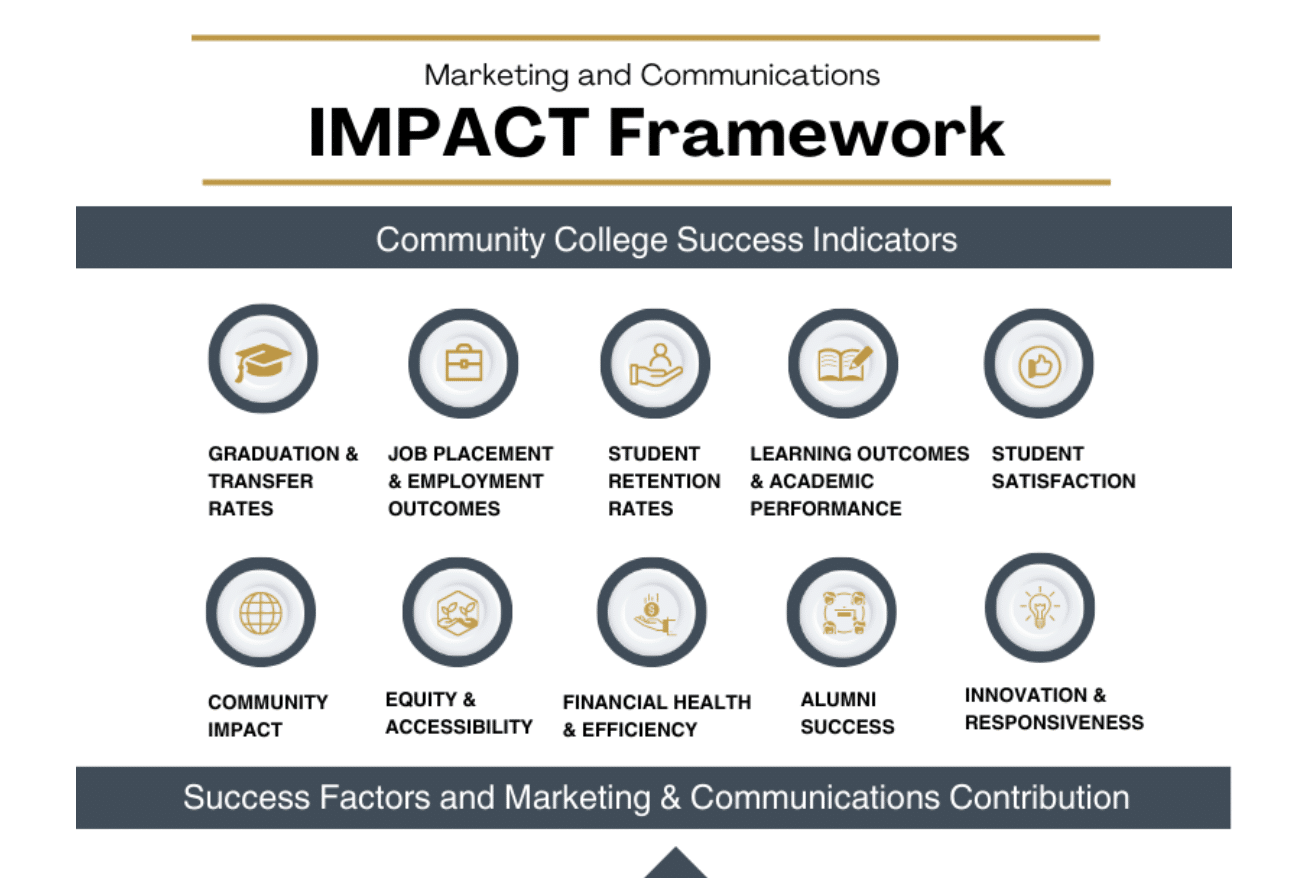Podcast
Episode 17
Streamlining Internal Communications to Improve Engagement and Efficiency

-
Episode Description
-
Guest Bio
-
Episode Transcript
In this episode of The Hidden Gem, Maya Demishkevich talks with Carrie Pitts-Densmore, VP of Enrollment and Marketing at Johnson Community College about transforming internal communications. Carrie shares her experience over the last three years in centralizing communication efforts, enhancing transparency, and building trust across departments. Discover how these initiatives have shaped a more informed and engaged campus community.
Key Takeaways:
Learn how Carrie tackled decentralized communicatios by conducting audits and centralizing efforts, leading to a more streamlined and efficient communication process across campus.
- Hear about the introduction of a weekly president's newsletter and a new faculty newsletter, which have significantly reduced redundant emails and improved overall communication flow.
- Discover the tools and systems used to manage internal communications, such as ticketing systems, digital monitors, and a consistent branding approach through Canva.
- Find out how creating a culture of trust, rather than just seeking "buy-in," has allowed the college to implement new processes and systems effectively.
- Get insights on breaking down communication silos with cross-departmental committees, open-door policies, and new initiatives like the "Johnson Community College 101" guide.
Carrie Pitts-Densmore / Vice President of Enrollment and Marketing / Johnston Community College
Carrie Pitts-Densmore serves as the Vice President of Enrollment and Marketing at Johnston Community College. With 25 years of experience in communications, including 13 years focused on integrated marketing and public relations, Carrie has built a diverse and impactful career. She began as a television news journalist, earning a national award for a documentary on domestic violence and covering significant news events in Myrtle Beach, Buffalo, and Raleigh. Transitioning from news, she became a consultant, advising organizations on video production, media relations, strategic communications, and marketing. Carrie also excelled as a real estate agent for a few years, where she developed her customer relations and technology skills, winning multiple awards. Today, she thrives in higher education, embracing the dynamic intersection of technology and storytelling. Carrie holds an Accreditation in Public Relations (APR) and a Master of Science in Communications from Purdue University. Outside of work, she enjoys yoga, the ocean, watching documentaries, and spending time with her family, including her son Archer and her husband Shawn.
Podcast Transcript: "Transforming Internal Communications at Johnson Community College" with Carrie
Maya (00:01):
Welcome back to The Hidden Gem Podcast! Today, I’m thrilled to speak with Carrie from Johnson Community College. She has extensive experience in public relations, TV, and communications, so I’m excited to learn from her. Welcome, Carrie!
Carrie (00:20):
Thanks for having me, Maya. I’m excited to be here.
Maya (00:25):
Our focus today is on internal communications—a crucial topic. How long have you been at Johnson Community College?
Carrie (00:41):
A little over three and a half years now.
Maya (00:44):
What was the state of internal communications when you joined the college, especially during COVID?
Carrie (01:15):
When I arrived, communications were highly decentralized. If someone needed to share something, they had to handle it themselves. The PIO (Public Information Officer) role, which I hold, wasn’t involved in moderating emails, didn’t have access to student communications, and wasn’t part of the president’s cabinet.
Two years ago, an interim president recognized the importance of having the PIO on the cabinet, which was a game-changer. Our current president has emphasized transparency and improved communication. We’ve come a long way, but we know there’s always room for improvement.
Maya (03:05):
How did you approach transforming internal communications?
Carrie (03:32):
We began by integrating the PIO role into key communication processes and conducting an audit of existing communication channels. We identified inefficiencies and redundancies and offered to centralize efforts through our department.
In January, we launched a weekly president’s newsletter, gathering updates from departmental newsletters, the president’s cabinet, and our events process. It’s archived on our intranet, so people can revisit it anytime.
Maya (05:55):
Do you usually send the newsletter on Mondays?
Carrie (06:02):
Yes, unless it’s a holiday. While not everyone opens it, those who do rely on it. We also have a faculty newsletter from our vice president of instruction, which is incredibly helpful.
Maya (07:08):
What systems and tools do you use to manage communications?
Carrie (07:29):
Externally, we use Element451 as our CRM for prospective and student communications. Internally, we rely on Outlook for newsletters, but I design them in Element451 for a consistent look.
We use a ticketing system for communication requests, which keeps everything organized. Additionally, we’ve implemented NeoEd for policy management and digital monitors across campus to display updates.
Maya (10:20):
How do you ensure brand consistency internally?
Carrie (10:51):
We created branded Canva templates for every division and department. This ensures that even unique designs remain consistent with our brand. These templates are used for presentations, newsletters, and event materials, making the brand more visible.
Maya (12:04):
How do you handle communication requests from departments?
Carrie (12:40):
We revised our ticketing system to focus on strategic goals. Instead of asking, “What do you want?” we now ask, “What are you trying to communicate and to whom?” This helps us determine whether a request is tactical (e.g., a website update) or strategic (e.g., a campaign).
We also evaluate requests based on their alignment with our goals, such as enrollment, retention, or recruitment.
Maya (15:45):
You’ve mentioned the importance of trust over buy-in when implementing changes. Can you elaborate?
Carrie (16:15):
People often misunderstand “buy-in” as unanimous agreement, which is unrealistic. It’s really about building trust in the process.
For example, when we reduced student emails, faculty trusted us to handle messaging effectively. Trust grows as people see results. It’s not about avoiding mistakes—it’s about learning and improving together.
Maya (18:49):
How do you decide what to email versus what to post on portals or display on monitors?
Carrie (23:28):
The size of the audience determines the platform. For broad events like a blood drive, we use multiple channels: newsletters, monitors, and our events calendar. For niche communications, like club announcements, we target specific groups using our CRM.
The president’s newsletter has also reduced the need for one-off emails by consolidating key updates.
Maya (27:14):
What other steps have you taken to improve internal communication?
Carrie (27:42):
We restructured committees to improve cross-departmental communication. Agendas and minutes are posted on SharePoint for transparency. Cabinet meeting minutes are also shared weekly.
Additionally, we’ve started “director meetings” to compile a JCC 101 guide—a comprehensive resource for new employees outlining essential departmental information.
Maya (33:07):
That’s a fantastic idea, especially for onboarding new employees. Anything else you’d like to share about internal communication initiatives?
Carrie (33:55):
We prioritize an open-door policy. Our president and cabinet members are accessible for concerns or suggestions.
We’ve also implemented a digital suggestion box, and every submission is taken seriously. Transparency and approachability are key to fostering trust and engagement.
Maya (36:03):
This has been an inspiring conversation. Kudos to you and your team for prioritizing internal communication—it’s vital for fostering a strong, engaged community. Thank you so much for sharing your insights!
Carrie (37:30):
Thank you, Maya! It’s been a pleasure.
Don't miss new episodes!
If you enjoyed this episode, I’d really appreciate it if you could help spread the word—whether by sharing it with your colleagues, posting on social media, or leaving a review. Your support means a lot!
The IMPACT Framework
At the heart of the podcast lies the IMPACT framework that answers a pivotal question: What is the role of marketing and communications in the success of community colleges? This framework answers it by showcasing how these domains are not peripheral but central to amplifying the success of the institution.

Copyright 2025 College Crusader, all rights reserved.
